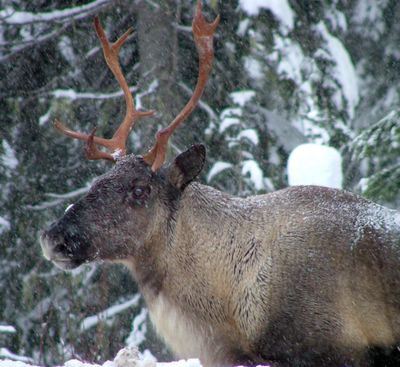Caribou protection worries officials

Protecting habitat for woodland caribou will create economic hardships in Bonner County’s rural communities, its board of commissioners said Tuesday, predicting that the designation would create new restrictions on logging, snowmobiling and forest access.
The U.S. Fish and Wildlife Service has proposed designating more than 375,500 acres in the Selkirk Mountains as critical habitat for woodland caribou, an endangered member of the deer family. Nearly 80 percent of the proposed habitat is on federal land in Idaho’s Bonner and Boundary counties and Washington’s Pend Oreille County.
Federal officials say the proposed habitat designation would impose nominal new restrictions on logging, winter recreation and other forest activities. Most existing activities can continue, though some modifications may be needed to protect caribou, said Joan Jewett, a Fish and Wildlife Service spokeswoman in Portland.
As part of the critical habitat designation process, the agency will also conduct an economic analysis of the proposal, which could result in boundary adjustments. But skeptical Bonner County commissioners referred to the proposal as a “de facto wilderness” designation this week.
“We’ve already had a lot of road closures,” said Cornel Rasor, the board’s chairman. “These are our public lands.”
Rasor cited the Priest Lake area as an example of a rural community that would be impacted. Priest Lake businesses depend on snowmobiling for winter tourism revenue, and the local economy is already suffering from earlier court-ordered closures of some snowmobile terrain to prevent caribou from being displaced from their winter habitat, he said.
On Tuesday, Bonner County commissioners passed a resolution saying the federal government must coordinate with county officials on activities that conflict with Bonner County’s land use plan. Rasor said the commissioners passed the resolution to force the federal government to work directly with them on the caribou habitat designation. But it wasn’t immediately clear Tuesday what impact the resolution – which cites the U.S. Constitution and the Federal Land Policy and Management Act – would have.
“We haven’t seen the resolution so we can’t comment on it, but we would love to hear their concerns,” said Meggan Laxalt Mackey, a Boise spokeswoman for the Fish and Wildlife Service. The agency is accepting public comments through Jan. 30. After the economic analysis is released, another 30-day comment period will be scheduled, she said.
Caribou in the southern Selkirk herd rely on old-growth forests above 4,000 feet for survival. When the snow deepens, caribou feed almost exclusively on lichens growing on trees that are 125 years old or older.
About 46 caribou are believed to remain in the southern Selkirk herd, whose territory includes southern British Columbia as well as parts of North Idaho and northeast Washington. Low reproductive rates, high calf mortality and loss of secure habitat have hampered caribou recovery efforts.
In 2002, several environmental groups petitioned the Fish and Wildlife Service to designate critical habitat for caribou. Recovering the woodland caribou requires protecting the places the animals use, said Brad Smith, who works for the Idaho Conservation League in Sandpoint. But caribou recovery and winter recreation aren’t mutually exclusive, he said.
“I think there’s room in the Selkirks to protect the habitat that caribou need to survive and recover … and also provide places for people to go snowmobiling, which is a legitimate use of public land,” Smith said.